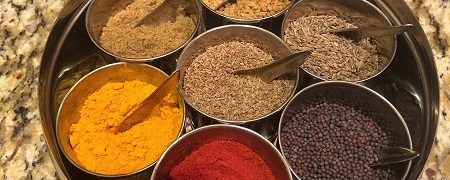Print Granola Breakfast Cookies Prep time: 30 mins Cook time: 15 mins Total time: 45 mins Serves: 22 to 24 Ingredients ¾ cup coconut oil or ghee 1 cup shredded jaggery ½ cup maple syrup ½ cup unsweetened apple sauce or 1 ripe banana, mashed 1 teaspoon vanilla extract 1 cup whole wheat flour ½ cup […]
Kachi Keri Nu Shaak
In beginning of Spring, you start to see various varieties of mango in markets of India. Some unripe varieties are used for making pickles. Some of these mangoes are also used in making chaats, chutneys, curries and salads. This unripe (kachi) mango (keri) nu shaak (curry) is similar to mango chutney but uses pickle masala […]
Gota (fritters)
Gota (fritters) are made with chickpea flour and vegetables. The most common type of gota is methi (fenugreek) ni bhaji (greens) na gota (fritters). Fenugreek greens are widely available during winter months. Gota is very popular street food and usually eaten as a snack with hot tea. When you buy gota from a street vendor […]
Holi Festival Food
Holi festive also known as festival of colors is celebrated in Spring. On the day of Holi, bonfires are lite at night to celebrate the victory of good over evil. Every festival has a special food associated with that occasion. Growing up for me, it was eating boiled whole wheat sev (noodles) with ghee and […]
Watermelon Poke Bowl
A poke bowl is associated with raw marinated fish, like Ahi or Yellowfin tuna, that’s cubed and served over sticky rice and pickles. It is originated in Hawaii. The meaning of poke is to slice or cut in Hawaiian and this vegetarian version with watermelon makes perfect sense. The combination of sweet watermelon, sour pickles […]
Cauliflower Rolls
New England is famous for lobster rolls during summer. Living in New England I was looking for similar rolls in a vegetarian version which can be served while entertaining or picnicking outside. Why not cauliflower which can mimic same flavor as lobster and when it has become trendy to make rice to pizza crust from […]
Chile Relleno with Paneer
Print Chile Relleno with Paneer Prep time: 30 mins Cook time: 1 hour Total time: 1 hour 30 mins Serves: 4 Ingredients 4 poblano peppers 1 recipe of paneer bhuraji 1 recipe of tikka masala gravy Directions Make paneer bhuraji and tikka masala gravy according to directions. Char poblano peppers on open flame of stove or […]
Ladoo
Ladoos are made thoughout in India at home and also readily available in sweet shops. The round shaped sweet is called ladoo and there are many varieties of ladoo. Different types of ladoos are made depending on occasion and festival. This sweet is favorite of children. It can be eaten as a snack or with […]
Panchrav Shaak
During month of August or September (on the eight day of Shravan Vad in Hindu calender) people in India celebrate Lord Krishna’s birth. The festival is known as Janmashtami. This year it was on August 24, 2019. People observed fast on that day. The next day which is called Parna, feast is prepared as an […]
Everyday Cabbage (shaak)
Print Everyday Cabbage (shaak) Prep time: 10 mins Cook time: 15 mins Total time: 25 mins Serves: 6 This is a basic recipe to cook any vegetable in Gujarati style and it is referred as shaak. Usually there is some kind of a shaak with a meal (Gujarati thali). In vegetables like cauliflower, cabbage, green beans, […]
Karela nu Shaak
Print Karela nu Shaak Prep time: 15 mins Cook time: 25 mins Total time: 40 mins Serves: 4 Karela (biiter melons) are usually available during mango season (April to July) in Gujarat. Here in US they are available all year around. This shaak is especially eaten with mango pulp. Both works well together as karela are […]
Singapore Noodles
Print Singapore Noodles Prep time: 15 mins Cook time: 15 mins Total time: 30 mins Serves: 4 This noodle recipe is the result of influence of Indian and Chinese cuisine in Singapore. Ingredients ½ cup neutral oil, divided 2 tablespoons curry powder ¼ teaspoon or to taste cayenne pepper 8 oz. rice noodles (vermicelli) 3 tablespoons […]
